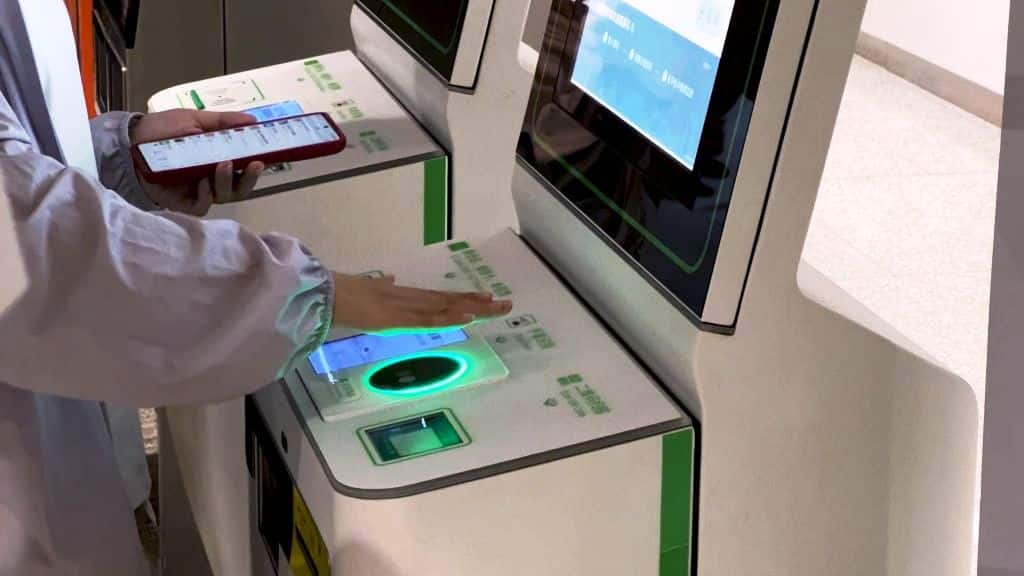
Tencent, the tech giant based in Shenzhen, has introduced a cutting-edge palm scanning service in China, aiming to enable users to leave behind their house keys, wallets, or phones. While the technology itself is not novel, Tencent is determined to make it mainstream, as stated by Guo Rizen, a senior executive at the company. In an exclusive interview with CNN, Guo expressed confidence in the potential of this technology to become a new norm.
As a company deeply ingrained in catering to the masses, Tencent, the owner of WeChat, a widely-used Chinese platform, is venturing into Weixin Palm Payment. Launched in May for Weixin Pay users, WeChat’s sister app, this biometric system is currently limited to mainland China.
Weixin Palm Payment allows users to forego their smartphones or transit cards using services like the Beijing subway. By hovering their hands over a sensor, infrared cameras analyse palm prints and unique vein patterns under the skin, ensuring swift identification and payment processing within seconds.
According to Goode Intelligence, a consultancy firm, the global biometric payments market is projected to reach over 3 billion users and nearly $5.8 trillion in value by 2026. Recognizing this opportunity, JPMorgan initiated its payment authentication software pilot program using palm scanning last year.
Guo highlighted that the system, akin to facial recognition software but with greater accuracy, distinguishes individuals even among look-alike siblings. Unlike facial scanning, which can lead to similarities between people, palm payments rely on the uniqueness of palm prints and veins, providing heightened security.
This innovative application is also considered an advancement over systems employed by Japanese firms, where employees scan their palms for entry into office buildings. Guo pointed out that these traditional systems, requiring physical contact with monitoring devices, may face reluctance due to increased germ-consciousness following the pandemic.
Tencent’s Move into Contactless Transactions
Tencent, a prominent tech giant based in Shenzhen, has unveiled a contactless palm scanning service in China, joining the likes of Amazon and Fujitsu in biometric payments. Amazon, headquartered in Seattle, introduced its palm scanning payment service in 2020, enabling users to link palm prints to credit cards for purchases in cashier-free stores. Meanwhile, Fujitsu, the Japanese tech giant, has long provided a contact-free system for cybersecurity through its PalmSecure service, allowing users to authenticate online accounts by scanning their hands instead of relying on passwords.
Tencent, however, aspires to go beyond existing applications. Guo Rizen, a senior executive at Tencent, expressed the company’s ambition to integrate its platform into daily life, envisioning palm payments to alleviate the inconvenience of carrying physical items. This vision extends to various scenarios, such as Tencent staff using the system to access corporate canteens, eliminating the need for security passes. The technology is gradually permeating external spaces, with over 1,500 7-Eleven stores in the southern Chinese province of Guangdong adopting it. Additionally, Supermonkey, a popular Chinese gym chain, has embraced palm scanning, with around 2,000 users utilizing the technology for hassle-free check-ins and check-outs.
While Guo remains optimistic about the current response, he emphasizes that the palm scanning service is still in its early stages. The decision to expand its usage on a larger scale will be contingent on market demand and user feedback. Tencent is yet to determine whether to extend the service beyond mainland China, underscoring the cautious approach toward potential global expansion.
Addressing Privacy Concerns in the Age of Biometric Payments
While the adoption of biometric payment methods, such as Tencent’s Weixin Palm Payment, has been embraced by many consumers seeking convenience, concerns about privacy and security persist, according to Edward Santow, industry professor of responsible technology at the University of Technology Sydney.
Santow emphasized that consumers are apprehensive about participating in what they perceive as a potential surveillance state. The fear of having payment transactions appear on an official register, leading to intrusive questions or worse consequences, raises privacy concerns among users.
Moreover, Santow warned about the increased risk of data theft associated with collecting personal information on a large scale. He highlighted the potential creation of a honeypot for cybercriminals, where illegally obtained information could be sold on the black market, causing significant problems for individuals.
Responding to these concerns, Tencent reassured users that security and privacy are paramount. The company stated that users’ biometric data is encrypted on the cloud to ensure robust security measures. Guo emphasized that the palm scanning service operates strictly on an opt-in basis, allowing users to set their spending limits for authorized payments. However, the company did not disclose this service’s total number of users.
Guo argued that, from a security standpoint, carrying physical objects like credit cards or keys is more unsafe. He pointed out the risk of accidental loss, potentially leading to someone else having access to sensitive items. In light of this, Tencent envisions a future where physical items may no longer be necessary.
A user, Kate Xue, shared her perspective on the matter, expressing unquestionable certainty regarding the potential misuse of data. She suggested that information sharing may become a norm with the acceptance of AI and technological changes.

